The $260 Billion Lesson: How IBM’s Story Rewrites the Rules of Modern Investing
Picture this: It’s 2013, and IBM’s stock hits an all-time high of $215.90. Warren Buffett calls it a “durable competitive advantage.” Fast-forward to 2024, and those same shares trade at $167—a 23% decline despite a historic bull market. This isn’t just a stock chart. It’s a $260 billion vanishing act that rewrites everything investors thought they knew about “safe” blue-chip bets. IBM’s 112-year arc—from punch cards to AI—is a masterclass in how even titans fall when they mistake dominance for destiny. Let’s dissect why this matters for your portfolio today.
I. The Rise: How IBM Built a Century-Long Monopoly (1911-1990)
A. The Machinery of Power
IBM didn’t just sell typewriters. They sold control. When the U.S. government needed to process 26 million Social Security records in 1935, IBM’s tabulating machines turned chaos into order—and locked in a 30-year federal contract. Key moves:
- Vertical integration: Owned everything from R&D to customer training centers
- Rental model: 85% of 1960s revenue came from leases, not sales
- Antitrust immunity: The DOJ sued IBM for monopoly…and lost in 1982
B. The Mainframe Empire
IBM’s System/360 (1964) was the iPhone of its day—a $5 billion bet (equivalent to $45 billion today) that unified hardware/software. Results?
| Metric | 1965 | 1975 |
|---|---|---|
| Revenue | $3.6B | $14.4B |
| Net Margin | 14.2% | 18.9% |
| Market Share | 70% | 82% |
Source: IBM Annual Reports, 1965-1975
II. The Golden Age: When IBM Was the Market (1980-1999)
A. The PC Paradox
IBM invented the modern PC in 1981…and handed Microsoft and Intel the keys to the kingdom. Why? A fatal assumption: “Hardware will always drive profits.” By 2005, IBM sold its PC division to Lenovo for just $1.75B—less than 3% of Microsoft’s value at the time.
B. Services Over Software
Lou Gerstner’s 1993 pivot to IT services saved IBM from near-bankruptcy but planted the seeds of decline. Services revenue grew from $13B (1993) to $56B (2008), but:
- Margins fell from 41% (hardware) to 28% (services)
- Cloud computing was dismissed as “a passing fad” (2008 internal memo)
| Business Line | 1995 Revenue | 2010 Revenue |
|---|---|---|
| Hardware | $27B | $18B |
| Services | $13B | $56B |
| Software | $11B | $22B |
Source: IBM 10-K Filings
III. The Unraveling: 7 Fatal Mistakes That Crushed a Titan (2000-2024)
A. Innovation Myopia
IBM invented the first AI system (Deep Blue) in 1997 but missed the AI boom. From 2015-2020, they spent $18B on R&D—yet today hold just 2% of the $200B AI market (IDC, 2023).
B. The Cloud Catastrophe
While AWS grew at 42% annually, IBM’s cloud revenue grew at 7% (2015-2020). Result? A 75% decline in data center sales since 2010.
C. Financial Engineering Overhaul
IBM spent $143B on buybacks (2000-2020)—equal to 55% of its current market cap. Meanwhile, R&D fell from 6.2% to 3.8% of revenue.
Critical Stat: $1 invested in IBM in 2013 became $0.77 by 2023. $1 in Amazon became $10.90.
IV. The Investor’s Playbook: Spotting the Next IBM (Before It’s Too Late)
A. The 3 Warning Signs
- Buybacks > R&D: Companies spending more on stock manipulation than innovation
- Margin Erosion: Services-heavy models with sub-30% gross margins
- Leadership Blindspots: CEOs who dismiss disruptors (see IBM’s 2010 cloud comments)
B. The Anti-IBM Framework
Contrast IBM’s decline with Microsoft’s resurgence under Nadella:
| Metric | IBM (2023) | Microsoft (2023) |
|---|---|---|
| Cloud Growth | 4% | 24% |
| R&D % Revenue | 3.8% | 13.2% |
| AI Patents | 1,200 | 5,800 |
Source: Gartner, USPTO
V. The New Titans: Where to Look Now
IBM’s collapse created $1.3T in market cap opportunities for others. The takeaway? Invest in companies that:
- Allocate >10% of revenue to R&D
- Have <1.5 debt-to-equity ratios
- Pivot before crises (see NVIDIA’s AI shift in 2016)
Your Move: The Investor’s Advantage
IBM’s story isn’t about failure—it’s about pattern recognition. Every quarter, screen your holdings for:
- Revenue concentration in sunset industries
- Declining R&D spend as % of sales
- Leadership teams repeating “We’ve always done it this way”
The next tech tsunami is always brewing. Will your portfolio ride the wave—or drown in complacency? Start by revisiting one “safe” stock in your portfolio tonight. Ask: “What would 2013 IBM do?” Then do the opposite.


Leave a Reply